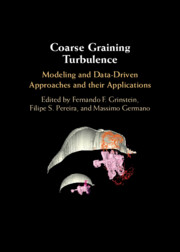Book contents
- Frontmatter
- Contents
- Contributors
- Prologue
- Part I Paradigms and Tools
- 1 Numerical Simulations and Coarse-Graining
- 2 An Overview of Scale-Resolving Simulation Models for Practical Flows
- 3 Filtering Approaches and Coarse Graining
- 4 Filtered Density Function
- 5 Symmetries, Subgrid-Scale Modeling, and Coarse Graining
- 6 Coarse-Graining Turbulence Using the Mori–Zwanzig Formalism
- 7 Data-Driven Modeling for Coarse Graining
- 8 Verification, Validation, Uncertainty Quantification, and Coarse-Graining
- Part II Challenges
- Epilogue
- Abbreviations
- Index
- References
1 - Numerical Simulations and Coarse-Graining
from Part I - Paradigms and Tools
Published online by Cambridge University Press: 31 January 2025
- Frontmatter
- Contents
- Contributors
- Prologue
- Part I Paradigms and Tools
- 1 Numerical Simulations and Coarse-Graining
- 2 An Overview of Scale-Resolving Simulation Models for Practical Flows
- 3 Filtering Approaches and Coarse Graining
- 4 Filtered Density Function
- 5 Symmetries, Subgrid-Scale Modeling, and Coarse Graining
- 6 Coarse-Graining Turbulence Using the Mori–Zwanzig Formalism
- 7 Data-Driven Modeling for Coarse Graining
- 8 Verification, Validation, Uncertainty Quantification, and Coarse-Graining
- Part II Challenges
- Epilogue
- Abbreviations
- Index
- References
Summary
Accurate predictions with quantifiable uncertainty are essential to many practical turbulent flows in engineering, geophysics, and astrophysics typically comprising extreme geometrical complexity and broad ranges of length and timescales. Dominating effects of the flow instabilities can be captured with coarse-graining (CG) modeling based on the primary conservation equations and effectively codesigned physics and algorithms. The collaborative computational and laboratory experiments unavoidably involve inherently intrusive coarse-grained observations – intimately linked to their subgrid scale and supergrid (initial and boundary conditions) specifics. We discuss turbulence fundamentals and predictability aspects and introduce the CG modified equation analysis. Modeling and predictability issues for underresolved flow and mixing driven by underresolved velocity fields and underresolved initial and boundary conditions are revisited in this context. CG simulations modeling prototypical shock-tube experiments are used to exemplify relevant actual issues, challenges, and strategies.
- Type
- Chapter
- Information
- Coarse Graining TurbulenceModeling and Data-Driven Approaches and their Applications, pp. 5 - 47Publisher: Cambridge University PressPrint publication year: 2025

